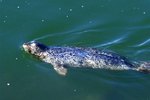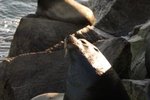
The hooded seal, scientific name Cystophora cristata, is a common semi-aquatic arctic fin-footed mammal, or pinniped. The hooded seal’s population has declined over time, warranting a moderately high at-risk classification on the International Union for Conservation of Nature and Natural Resources (IUCN) Red List of Threatened Species.
Description
The hooded seal is named for the large, elastic, inflatable hood, or balloon, that extends from the adult male’s forehead to its nose. This sac develops at around 4 years of age and can be inflated to demonstrate signs of aggression. Adults are gray with black patches and a black face and can grow to 10 feet long. Pups are called bluebacks due to their blue-gray coloring. The hooded seal is unsocial and more aggressive than other seal species, remaining alone except during mating season. The hooded seal can live between 30 and 35 years and mainly feeds on halibut, octopus, squid, shrimp, mussels, cod, herring, redfish, wolffish and starfish.
Habitat
The hooded seal is found on drifting pack ice in the deep waters of the north Atlantic, ranging from Svalbard in the northeast to the Gulf of Lawrence in the northwest. Four distinct populations live in this range, with an estimated population of 650,000. Breeding season is from April to June; then the seals linger to molt on nearby ice between June and August. They spend the rest of the year in solitary migration before returning to their breeding areas in late winter.
Threats
Historically the hooded seal was hunted by Greenland, Canada, the Soviet Union and Norway. The blueback pups were intensely hunted until 1983 when importation of blueback products was banned by the European Economic Community. The hooded seal was put under protection under the Marine Mammal Protection Act (MMPA) in 1972; however, illegal hunting still occurs today. These seals also get caught in gillnets and because of overfishing may have to migrate further south than before to find food. Their predators include polar bears, Greenland sharks and killer whales.
Conservation Status/Protection
The hooded seal is listed as vulnerable (VU), on the IUCN Red List, meaning it is considered endangered and at high risk of extinction. This classification is justified by the steadily declining populations of seals in the northwest breeding areas, despite the fact that the northeast populations seem to be stable. According to the IUCN website, conservation efforts date back to the 1870s, and include the licensing of sealers and the establishment of harvest quotas, treaties and management plans. Conservation efforts are ongoing.
References
Photo Credits
-
icelands icecap image by Deborah Benbrook from Fotolia.com
Writer Bio
Sarah Quinlan has experience writing for various websites on science, biology, veterinary science, health and medicine. For over seven years she has worked as a scientist in various biological fields where she has written and contributed to multiple manuscripts that have been published in scientific journals. Quinlan holds a bachelor's degree in zoology and a master's degree in forensic biology/chemistry.




